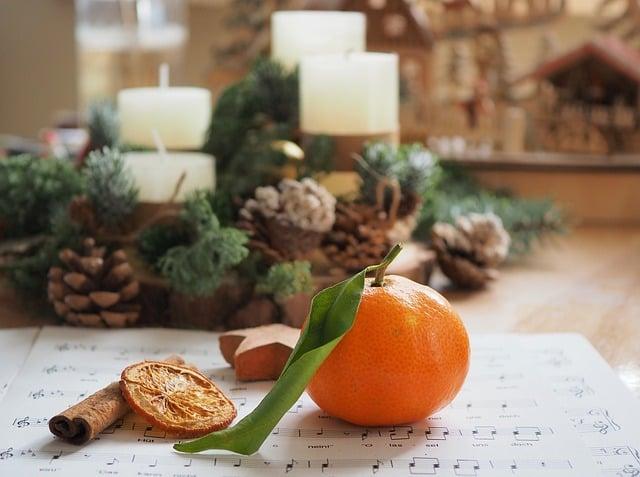As the first candle flickered to life, Sarah pondered the origins of Advent. Her grandmother had always said it was a time of hope, a countdown to Christmas. Yet, whispers of pagan roots danced in her mind. Curious, she delved into history, discovering that many traditions, like the Yule log and the winter solstice, predated Christianity. But rather than a clash, Sarah saw a beautiful tapestry woven from diverse threads. Advent, she realized, was not just a celebration of one faith, but a shared moment of light in the darkest days of winter.
Table of Contents
- Exploring the Historical Roots of Advent and Its Pagan Connections
- Understanding the Symbolism of Light in Advent Traditions
- Comparative Analysis of Advent and Pagan Winter Celebrations
- Embracing Advent: Recommendations for a Meaningful Celebration
- Q&A

Exploring the Historical Roots of Advent and Its Pagan Connections
The origins of Advent can be traced back to early Christian traditions, marking a period of preparation for the celebration of the birth of Jesus Christ. However, as Christianity spread across Europe, it encountered various local customs and beliefs, many of which had roots in ancient pagan practices. This blending of traditions has led to a rich tapestry of celebrations that often intertwine religious significance with seasonal festivities. Some of the elements that have been absorbed into the Advent season include:
- Winter Solstice Celebrations: Many cultures celebrated the return of the sun during the winter solstice, a time of rebirth and renewal that coincides with the Advent season.
- Yule Traditions: The Yule festival, celebrated by Germanic peoples, involved feasting, lighting candles, and decorating trees, practices that resonate with modern Advent customs.
- Nature Worship: Various pagan traditions honored the cycles of nature, emphasizing themes of hope and light that parallel the Christian message of Advent.
As these pagan customs merged with Christian beliefs, they transformed the way Advent was observed. The use of candles, for instance, symbolizes the light of Christ coming into the world, yet it also echoes ancient rituals that celebrated the return of light during the darkest days of winter. The Advent wreath, adorned with evergreens, serves as a reminder of eternal life, a concept that was prevalent in many pagan traditions. This fascinating interplay between the sacred and the secular invites us to reflect on how historical practices shape our contemporary celebrations, revealing a complex heritage that transcends simple categorization.

Understanding the Symbolism of Light in Advent Traditions
The symbolism of light during Advent serves as a profound reminder of hope and renewal, transcending its historical roots. As the days grow shorter and darker in the lead-up to Christmas, the use of light in various traditions becomes a beacon of faith and anticipation. Candles are lit each week, representing the journey toward the birth of Christ, illuminating the path from darkness to light. This ritual not only signifies the coming of Jesus as the “Light of the World” but also reflects a universal longing for warmth and guidance during the cold winter months.
In many cultures, the act of lighting candles or decorating with lights during this season can be seen as a way to combat the darkness, both literally and metaphorically. The **Advent wreath**, adorned with four candles, symbolizes the four weeks of Advent, while the **Christ candle** at the center represents the arrival of Jesus. Additionally, the use of **string lights** and **lanterns** in homes and public spaces echoes ancient practices of celebrating the winter solstice, where light was used to ward off evil spirits and bring joy. Thus, the symbolism of light in Advent traditions intertwines with various cultural practices, creating a rich tapestry of meaning that resonates with both religious and secular communities alike.
Comparative Analysis of Advent and Pagan Winter Celebrations
The intersection of Advent and ancient pagan winter celebrations reveals a fascinating tapestry of traditions that have evolved over centuries. While Advent is primarily a Christian observance marking the anticipation of Christ’s birth, many of its customs echo the rituals of pre-Christian winter festivities. For instance, the use of evergreen decorations, such as wreaths and trees, can be traced back to pagan practices that celebrated the resilience of nature during the cold months. These symbols of life amidst winter darkness were often used in various cultures to signify hope and renewal, themes that resonate deeply within the Advent season.
Moreover, the timing of Advent coincides with the winter solstice, a period rich in pagan significance. Many ancient cultures celebrated the return of the sun and the gradual lengthening of days, which aligns with the Christian theme of light entering the world through Jesus. The blending of these traditions has led to a unique cultural phenomenon where **feasting, gift-giving, and communal gatherings** are common in both Advent and pagan celebrations. This convergence raises intriguing questions about the origins of certain customs, such as the lighting of candles, which serve as a reminder of both the spiritual light of Christ and the natural light returning to the earth. Ultimately, the shared elements of these celebrations highlight a universal human desire to find joy and meaning during the darkest days of the year.

Embracing Advent: Recommendations for a Meaningful Celebration
As the season of Advent approaches, many seek to deepen their spiritual experience and create a meaningful celebration. One way to do this is by incorporating **traditions** that resonate with the essence of the season. Consider setting up an Advent wreath, adorned with four candles representing hope, peace, joy, and love. Each week, as you light a new candle, take a moment for reflection and prayer, allowing the flickering flames to symbolize the growing anticipation of the coming holiday. Additionally, you might explore the practice of daily devotionals or scripture readings that guide you through the themes of Advent, fostering a sense of connection to the historical and spiritual significance of this time.
Another enriching approach is to engage in **acts of service** and kindness throughout the Advent season. This could involve volunteering at local shelters, organizing food drives, or simply reaching out to those in need within your community. By focusing on giving and compassion, you embody the spirit of Advent, transforming it into a time of generosity and love. Furthermore, consider creating a family tradition of sharing stories or memories that highlight the importance of togetherness and gratitude, reinforcing the bonds that make this season truly special. Embracing these practices can lead to a more profound understanding of Advent, allowing you to celebrate it in a way that feels authentic and fulfilling.
Q&A
-
What is the origin of Advent?
Advent is a Christian season that marks the period of preparation for the celebration of the birth of Jesus Christ at Christmas. It traditionally begins four Sundays before Christmas and has roots in early Christian practices, rather than pagan traditions.
-
Are there pagan elements in Advent?
While some argue that certain customs associated with Advent, such as the use of evergreen decorations, may have pagan origins, these practices have been reinterpreted within a Christian context. The focus of Advent remains on spiritual preparation and reflection.
-
How do Christians view Advent?
For Christians, Advent is a sacred time of anticipation and hope. It is a period dedicated to prayer, reflection, and the celebration of the coming of Christ, distinguishing it from any pagan associations.
-
Can Advent be celebrated in a secular way?
Yes, many people celebrate Advent in a secular manner, focusing on themes of joy, family, and community. This can include the use of Advent calendars and festive decorations, but the spiritual significance is often less emphasized.
As we unwrap the layers of Advent, we find a tapestry woven with threads of tradition, faith, and history. Whether viewed through a pagan lens or a Christian one, this season invites reflection and connection, reminding us of the light that guides us all.

大家好,我是彼得潘,專業的手法身體治療師。我喜歡探索和研究各種主題,並透過與人工智慧的合作分享專業、實用、有趣的文章。我們定期進行人工審核,以確保內容的準確性。如果您發現文章中有任何不準確的地方,請隨時與我們聯繫,我們會及時糾正。您可以透過 [email protected] 與我們聯繫。



